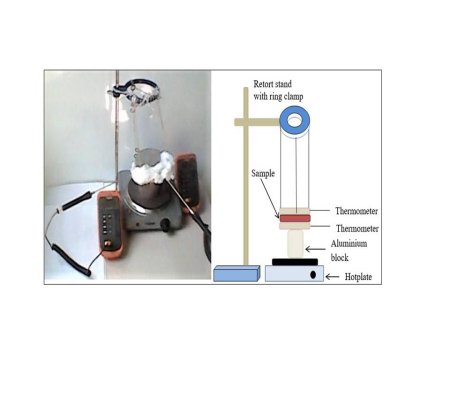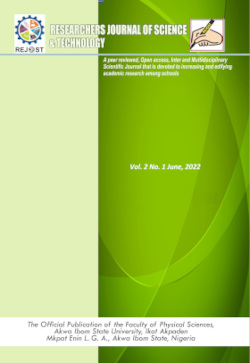On the Modification of Lee – Charlton’s Disc Apparatus Technique for Thermal Conductivity Determination
Keywords:
Accuracy, Fourier’s law, Measurement duration, Portability, Rate of cooling, Thermal insulantAbstract
In recent years, the demand for thermal insulation has been very high. Consequently, assorted new heat-insulating materials are being developed in order to meet the needs for thermal insulation in buildings, power engineering, refrigeration, spacecraft, mechanical systems, firemanship, installations, and industrial facilities among others. Enhancement of effective thermal conductivity investigation for such materials requires the use of a device that is inexpensive, time-saving, easy-to-use, and capable of rendering reliable/accurate results for a wide range of the materials. If not that the traditional Lee – Charlton’s Disc (TLD) apparatus set-up usually requires a long-time duration to attain thermal balance, it would be the best fit for the task, thus warranting the design of a modified Lee – Charlton’s Disc (MLD) apparatus set-up to solve this problem. Achievement of time-saving in this new approach was feasible by using two metallic discs with electric hotplate or bunsen burner (instead of water) for heating purpose. The present study sought to proffer the possibility of analysing samples that are significantly smaller than the size of the heating element of an available electric hotplate and also compare the MLD apparatus set-up with that of TLD. Steady-state durations were measured. Also, the total weight of components in each set-up was determined and compared for appraisal of portability. It was observed that measurement (steady- state) durations were reduced by about 66.2 % to 66.7 % when using MLD apparatus technique over TLD technique to analyse samples of same dimensions prepared from a particular material. Aside being simple and about 56.69 % to 92.91 % more portable, the MLD apparatus set-up technique rendered more accurate thermal conductivity results than those obtained by employing the TLD apparatus technique. Generally, it was noticed that the MLD apparatus technique could satisfy the above-mentioned conditions with uncertainty better than 1.5 % if applied for determination of thermal conductivity of thermal insulation materials having thickness of up to about 9.0mm.
References
Akpabio, G.T., Ituen, E.E., Ikot, A.N., (2010). A comparative study of the thermal properties of different soil samples for moulding blocks for a passively cooled building design. International Journal of Pure and Applied Physics, 6(4), 517 – 521.
Alam, M., Rahman, S., Halder, P. K., Raquib, A., Hasan, M., (2012). Lee’s and Charlton’s method for investiga-tion of thermal conductivity of insulating materials. IOSR Journal of Mechanical and Civil Engineering, 3(1), 53 – 60, https://doi.org/10.9790/1684-0315360.
Alausa, S. K., Oyesiku, O. O., Aderibigbe, J. O., Akinola, O.S., (2011). Thermal properties of Calamus deëratus, Raphia hookeri, and synthetic board in building design in South Western Nigeria. African Journal of Plant Science, 5(4), 281 – 283.
Al-Homoud, M. S., (2005). Performance Characteristics and practical applica-tions of common building thermal insu-lation materials. Building and Environment, 40, 353 – 366, https://doi.org/10.106/j.buildenv.2004.05.013.
ASTM C177 (2019). Standard Test Method for steady-state Heat flux measurements and thermal transmission properties by means of the Guarded-Hot-Plate apparatus. ASTM International, West Conshohocken, PA, https://doi.org-/10.1520/D0177-19.
ASTM C1045 (2019). Practice for calculating thermal transmission properties under steady- state conditions. ASTM International, West Conshohocken, PA, https://doi.org-/10.1520/D1045-19.
ASTM C518 (2021). Standard Test Method for steady-state thermal transmission properties by means of the Heat Flow Meter apparatus. ASTM International, West Conshohocken, PA, https://doi.org/-10.1520/C0518-17.
ASTM D5334 (2022). Standard Test Method for determination of thermal conducti-vity of soil and soft rock by thermal needle probe procedure. ASTM International, West Conshohocken, PA, https://doi.org/10.1520/D5334-14.
Clarke, R.E., (2017). High - conductance measurement with Heat Flow Meter apparatus. Ph D Thesis, RMIT Univer-sity.
Czichos, H., Saito, T., Smith, L. E., (2006). Springer Handbook of Materials Measurement Methods. 1st edition., Springer Science & Business Media, New York, p. 1208, https://doi.org/-10.1007/978-3-540-30300-8.
Dominguez-Muñoz, F., Anderson, B., Cejudo-López, J.M., Carrillo-André, A., (2010). Uncertainty in the thermal conductivity of insulation materials. Energy and Buildings, 42, 2159 – 2168.
Elkholy, A., Sadek, H., Kempers, R., (2019). An improved transient plane source technique and methodology for measuring the thermal properties of anisotropic materials. International Journal of Thermal Sciences, 135, 362 – 374, https://doi.org/10.1016/j.ijthermalsci.-2018.09.021.
Engineering Toolbox (2004). Metals and Alloys – Densities, https://www.-engineeringtoolbox.com/metals-alloys-densities-d_50.html.
Etuk, S. E., Akpabio, L. E., Akpabio, K. E., (2005). Determination of thermal properties of cocos nucifera trunk for predicting temperature variation with its thickness. Arabian Journal for Science and Engineering, 30(1), 121 – 126.
Etuk, S. E., Robert, U. W., Agbasi, O. E., (2020). Design and performance evaluation of a device for determi-nation of specific heat capacity of thermal insulators. Beni-Suef University Journal of Basic and Applied Sciences, 9(34), 1 – 7, https://doi.org/10.1186-/s43088-020-00062-y.
Etuk, S. E., Robert, U. W., Agbasi, O. E., (2021). Investigation of heat transfer and mechanical properties of Saccha-rum Officinarum leaf boards. Interna-tional Journal of Energy and Water Resources, 6(1), 95 – 102, https://doi.org-/10.1007/s42108-021-00123-7.
Flori, M., Puton, V., Vîlceanu, L., (2017). Using the heat flow plate method for determining thermal conductivity of building materials. IOP Conference Series: Materials Science and Engineering, 163, 012018, https://doi.org/10.1088/1757-899X/163/1/-012018.
George, N. J., Obianwu, V. I., Akpabio, G. T., Obot, I. B., (2010). Comparison of thermal insulation efficiency of some select materials used as ceiling in building design. Archives of Applied Science Research, 2(3), 253 – 259.
Gesa, F. N., Atser, A. R., Aondoakaa, I. S., (2014). Investigation of the thermal insulation properties of selected ceiling materials used in Makurdi metropolis (Benue State – Nigeria). American Journal of Engineering Research, 3(11), 245 – 250.
González-Domínguez, P. I., Monzón-Verona, J. M., García-Alonso, S., (2019). New Thermal–conductivity Constitutive Matrix in Fourier’s law for heat transfer using the cell method. Applied Sciences, 9(21), 4521, https://doi.org/10.3390/app9314521.
Hoseini, A.,McCague, C., Andisheh-Tadhir, M., Bahrami, M., (2016). Aerogels blankets: From mathematical modelling to material characteristics and experimental analysis. International Journal of Heat and Mass Transfer, 93, 1124 – 1131, https://doi.org/10.1016-/j.ijheatmasstransfer.2015.11.030.
ISO 8301 (2019).Thermal insulation — Determination of steady-state thermal resistance and related properties-Heat flow meter apparatus.
ISO/IEC Guide 98-3 (2008). Uncertainty Measurement Part 3: Guide to the expression of uncertainty in measure-ment. 1st edition, pp. 1 – 130.
Jannot, Y., Degiovanni, A., Grigorova-Moutiers, V., Godefroy, J., (2017). A passive guard for low thermal conductivity measurement of small samples by hot plate method. Measurement Science and Technology, 28, 015008, https://doi.org/10.1088/13-61-6501/28/-1/015008.
Jayachandran, S., Prithiviraajan, R. N., Reddy, K. S., (2017). Characterisation of various two- phase materials based on thermal conductivity using modified transient plane source method. AIP Conference Proceedings, Journal of Applied Physics, 1859(1), 020008, https://doi.org/10.63/1.4990161.
Kharshiduzzaman, M., Hossain, M.S., Ali, S., Ahmed, S., (2019). Determination of the thermal conductivity of poor conductive materials in the form of disc by self- constructed Lee’s Disc apparatus, AIP Conference Proceedings, 2121(1), 140008, https://doi.org/-10.1063/1.5115959.
Kobari, T., Okajima, J., Komiya, A., Maruyama, S., (2015). Development of guarded hot plate apparatus utilising Peltier Module for precise thermal conductivity measurement of insulation materials. International Journal of Heat and Mass Transfer, 91, 1157 – 1166, https://dx.doi.org/10.1016/j.ijheatmasstransfer.2015.08.044.
Krupa, P., Malinarič, S., (2014). Using the Transient Plane Source Method for measuring Thermal parameters of electroceramics. International Journal of Mechanical and Mechatonics Engi-neering, 8(5), 735 – 740.
Laskowski, J., Millow, B., Ratke, L., (2016). Aerogel-Aerogel composites for normal temperature range thermal insulation. Journal of non-crystalline solids, 441(1), 42 – 48.
Lei, Z., Zhu, S., Pan, N., (2010). Transient methods of Thermal properties measurement on fibrous materials. Journal of Heat Transfer, 132(3), 1 – 7.
Li, Y., Shi, C., Liu, J., Liu, E., Shao, J., Chen, Z., Dorantes-Gonzalez, D.J., Hu, X., (2014). Improving the accuracy of the transient plane source method by correcting probe heat capacity and resistance influences. Measurement Science and Technology, 25(1), 015006, https://doi.org/10.1088/-0957.0233/25/1/015006.
Lide, D.R., (2005). CRC Handbook of Chemistry and Physics. 85th edn., CRC Press, Boca Raton, FL, p. 2298 (Section 12 – 220).
Log, T., Gustafsson, S.E., (1995). Transient Plane Source (TPS) technique for measuring thermal transport properties of building materials. Fire and Materials,19(1), 43 – 49, https://doi.org-/10.1002/fam.810190107.
Malinarič, S., (2013). Contribution to the Transient Plane Source Method for measuring Thermophysical properties of solids. International Journal of Thermophysics, 34, 1953 – 1961, https://doi.org/10.1007/s10765-013-1502-3.
Mgbenu, E.N., Ifedili, S., Menkiti, A.I., Onwuagba, B.N., (1999). Waves, Optics and Thermal Physics. Nigerian University Series, Africana-FEP Publishers Limited, Onitsha, Nigeria, ISBN 978-175-308-0,128 – 146.
Mohapatra, R.C., Mishra, A., Choudhury, B., (2014). Measurement on thermal conductivity of Pine wood dust filled epoxy composites. American Journal of Mechanical Engineering, 2(4), 114 – 119, https://doi.org/-10.12691/ajme-2-4-3.
Ochang, M.B., Jubu, P.R., Amah, A.N., Oche, J.L., (2018). Investigation of thermal properties of fabricated plaster of Paris-Rice husk ash composite with varying matrix- filler volume fractions for thermal insulation applications. American Journal of Engineering Research, 7(6), 215 – 222.
Okorie, U. S., Robert, U. W., Iboh, U. A., Umoren, G. P., (2020). Assessment of the suitability of tiger nut fibre for structural applications. Journal of Renewable Energy and Mechanics, 3(1), 32 – 39, https://doi.org/-10.25299/rem.2020.vol3(01).4417.
Rajput, E.R.K., (2015). Mass and Heat Transfer. 6th Revised edn., S. Chand & Company PVT, Ram Nagar, New Delhi, p.13, ISBN 978-81-219-2617-1.
Robert, U.W., Etuk, S.E., Umoren, G.P., Agbasi, O.E., (2019a). Assessment of thermal and mechanical properties of composites board produced from coconut (cocos nucifera) husks, waste newspapers, and cassava starch. International JournalThermophysics, 40(9),1 - 12, https://doi.org/10.1007/-s10765-019-2547-8.
Robert, U.W., Etuk, S.E., Agbasi, O.E., (2019b). Bulk volume determination by Modified Water Displacement Method. Iraqi Journal of Science, 60(8), 1704 – 1710, https://doi.org/10.24996/ijs.2019.-60.8.7.
Robert, U.W., Etuk, S.E., Agbasi, O.E., Okorie, U.S., (2021a). Quick determination of thermal conductivity of thermal insulators using a Modified Lee – Charlton’s Disc Apparatus Technique. International Journal of Thermophysics, 42(8), 1 – 20, https://-doi.org/10.1007/s10765-021-02864-3.
Robert, U. W., Etuk, S. E., Agbasi, O. E., Umoren, G. P., Inyang, N. J., (2021b). Investigation of thermophysical and mechanical properties of board produced from coconut (Cocos nucifera) leaflet. Environmental Technology & Innovation, 24(1), 101869, https://doi.org/10.1016/j.eti.-2021/101869.
Rubio, C. M., (2014). An approach to make more technical Thermal properties measure in porous media. Applied Ecology and Environmental Sciences, 2(2), 60 – 65, https://doi.org/10.-12691/aees-2-2-4.
Saadie, J. H., (2016). Assessing of Thermal conductivity, Physical and Mechanical properties of building insulation materials prepared from waste materials and gypsum. International Journal of Engineering and Technology, 16(4), 37 – 42.
Terzić, M.M., Milošević, N.D., Stepanić, N.M., Petričević, S.J., (2016). Development of a single-sided guarded hot plate apparatus for Thermal conductivity measurements. Thermal Science, 20(1), S321 – S329, https://doi.org/10.2298/TSCI151009226T
Tleoubaev, A., Brzezinski, A., (2003). Combined Guarded-Hot-Plate and Heat Flow Meter Method for absolute thermal conductivity tests excluding thermal contact resistance. Conference Paper: Thermal Conductivity 27/ Thermal Expansion 15. At: Knoxville, Tonnessee, USA

Downloads
Published
How to Cite
Issue
Section
License
Copyright (c) 2022 Researchers Journal of Science and Technology

This work is licensed under a Creative Commons Attribution-NonCommercial-NoDerivatives 4.0 International License.




